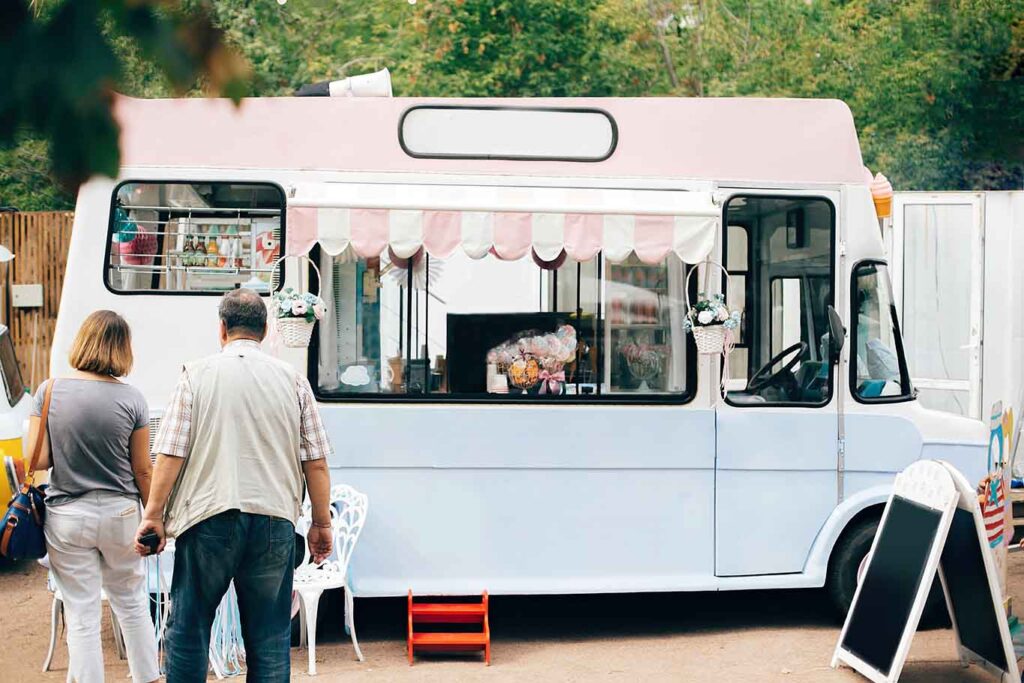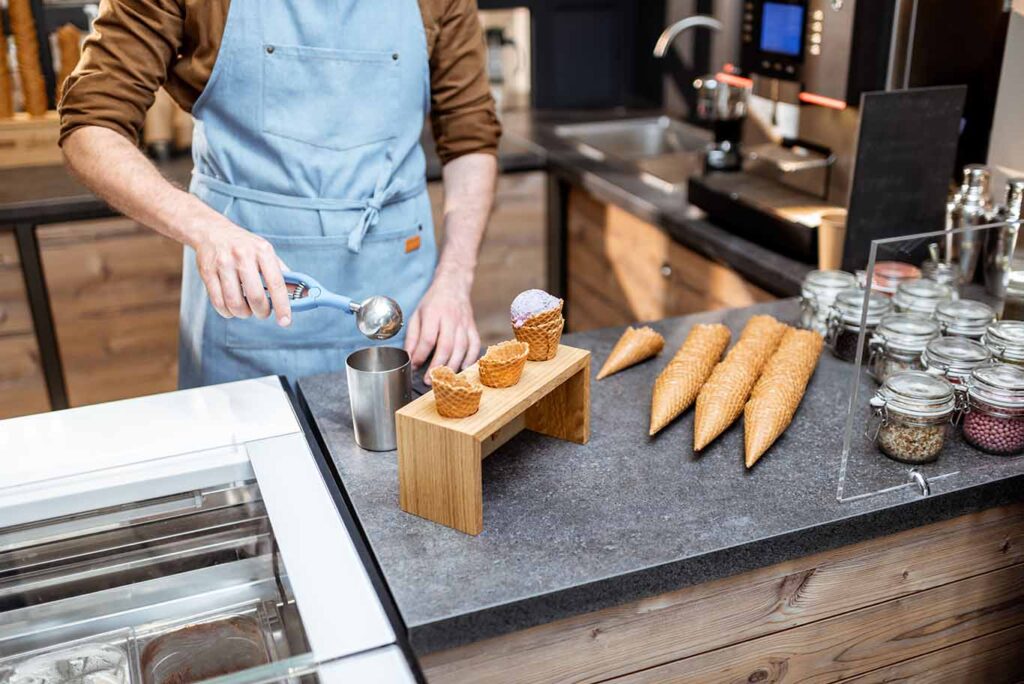Thinking about running an ice cream van? You might be wondering: Is it worth it? Can I actually make a decent living scooping 99s? Getting an ice-cream van up and running is fairly straightforward but to make money it depends on when, where, and how you operate, let’s look at how to make it work.
If you’ve been paying attention to the weather this year, you’ll know we’ve been experiencing one of the warmest UK summers on record. With the sun blazing and parks packed, ice cream vans across the country have seen sales absolutely surge. There’s never been a better time to get the scoop on what this business can really earn.
Ice cream vans have been a beloved part of British culture for over a century. Introduced by Italian immigrants in the early 1900s, they became icons of the 1960s high street, with their cheerful chimes and soft-serve cones. Though they dipped in popularity during the 2000s, a combination of nostalgia, foodie culture, and warmer summers has brought them roaring back.
In this guide, we’ll dig into the earnings potential of an ice cream van in the UK, exploring daily takings, seasonal highs and lows, best and worst spots, regional differences, and even a touch of history.
Why start an ice cream van business?
The Perks:
- Low startup costs compared to shops or cafes
- Flexibility to choose your hours, locations, and events
- High profit margins on core products
- Seasonal surges during spring and summer
- Brilliant for social and family-oriented entrepreneurs
The Challenges:
- Seasonal demand and weather dependency
- You need to get the right licences and permissions
- Van and equipment need regular upkeep
- Competition for pitches in busy spots
How much does it cost to start an ice cream van business?

Startup Costs (Approximate ranges)
| Item | Cost Range |
| Used ice cream van | £10,000 – £30,000 |
| Branding & refurbishments | £1,000 – £5,000 |
| First stock order | £500 – £1,500 |
| Licences & permits | £300 – £1,000 |
| Insurance | £500 – £2,000 |
| Optional POS system | £200 – £500 |
| Total Estimated | £12,500 – £40,000+ |
Ongoing Costs
- Fuel and restocking
- Cleaning and van maintenance
- Public liability insurance or specialist catering insurance renewal
- Event pitch fees or street trading licences
- Storage or off-road parking (especially off-season)
How much do ice cream vans make in the UK?
Let’s cut to the chase. Here’s what a typical UK ice cream van can earn:
Daily Takings (Estimates):
| Day Type | Average Takings | |
| Quiet weekday | £100 – £300 | |
| Busy weekend | £400 – £800 | |
| Local event/festival | £500 – £1,500+ | |
| Private hire (e.g. wedding) | £300 – £1,000+ |
Monthly/Seasonal Income:
- Summer (Apr–Sep): £4,000 – £10,000+ per month turnover
- Winter (Oct–Mar): £0 – £2,000/month, unless you diversify with hot desserts or events
Profit Per Product:
| Item | Sell Price | Cost Price | Profit |
| Mr Whippy cone | £2.50 | £0.30 | ~£2.20 |
| Cone with flake | £3.50 | £0.50 | ~£3.00 |
| Slush drink | £3.00 | £0.60 | ~£2.40 |
| Cold canned drink | £1.80 | £0.50 | ~£1.30 |
With high margins and a fast-paced sales model, ice cream vans can rake it in quickly, especially during peak events or sunny weekends.
Seasonal fluctuations

The UK weather is famously unpredictable – and your income can swing wildly with it.
Summer Peak
- Late April to early September is the prime window.
- During heatwaves, sales can skyrocket by 2x or even 3x in a day.
- Bank holidays and school breaks offer huge boosts.
Winter Low
- From October to March, most vans go into hibernation or switch to events and hot treats.
- Some diversify into churros, waffles, or hot drinks to stay afloat.
If you’re in it for the long haul, plan ahead financially to balance the off-season.
Regional differences: Where you operate matters
Not all ice cream van opportunities are created equal. Location plays a massive role in how much you can earn.
Coastal Areas
- Tourist towns around popular beaches and attractions are goldmines in summer.
- High footfall and holidaymakers = big money days.
Parks & Green Spaces
- Popular in cities and suburbs; ideal for weekends and school holidays.
- Getting permission or a regular pitch is key.
City Centres
- Can be a mixed bag – great foot traffic, but expensive permits and high competition.
Residential streets
- Slower paced, but steady income after school and on warm evenings.
Best and worst spots to sell ice cream
Top Spots
- Beaches and promenades
- Local parks on sunny weekends
- Music festivals, fairs, and car boot sales
- School events, weddings, and birthday parties
- Sports matches and local clubs
Worst Spots
- Isolated lay-bys (unless it’s a truck stop)
- Areas with strict council trading laws and no public footfall
- Locations too close to supermarkets or ice cream shops
- Overly saturated pitches with multiple vans
Licences & legal bits

Starting a van isn’t just about scooping ice cream – there’s a bit of paperwork and regulation to get sorted first. These legal requirements are essential not just for compliance, but also for building trust with customers and protecting your business.
Here’s what you’ll need:
Street trading licence
This is issued by your local council and gives you permission to trade in public spaces. Fees and application processes vary by region, and you may need to apply for specific locations or routes. Trading without it can result in fines or confiscation.
Food hygiene registration
You must register your ice cream business with your local authority at least 28 days before trading. This ensures your van complies with food safety standards. After inspection, you’ll be given a Food Hygiene Rating that must be displayed and is viewable online.
Public Liability Insurance
Having ice cream van insurance that covers public liability (as a minimum) is essential if you’re trading in public areas or attending events. It protects you in case someone is injured or suffers loss/damage due to your operations. You may also want to consider:
- Equipment cover (for machines, fridges, generators)
- Frozen goods insurance (in case of spoilage from power failure)
DBS checks
If you’re trading near schools or regularly interacting with children (e.g. school fairs), a DBS check may be required. It’s a background check that confirms you have no relevant criminal convictions, ensuring you’re safe to trade in sensitive areas.
Parking or storage permission
- Some councils require you to store your van off the road when not in use, especially if you’re keeping it in a residential area. You may also need a dedicated parking space for overnight storage. Check with your local council for specific requirements.
Common mistakes to avoid
Skipping the research: Trading without the right permits or underestimating costs
Picking the wrong pitch: A quiet spot will eat your profits
Not adapting for winter: Many vans go unused half the year
Neglecting marketing: You’re mobile – people need to know where you are!
Poor maintenance: Equipment breakdowns during peak hours = lost income
Marketing your ice cream van
Social media: Post daily locations on Instagram and Facebook
Local press or community boards: Especially for new vans or events
Loyalty cards & deals: Encourage return visits
Branding: A quirky or nostalgic van design makes you memorable
Online booking: Set up a simple site for hire enquiries
Is it still worth it in 2025?
Absolutely – but only if you plan smart. The days of just parking outside a school and waiting for a queue are gone. The winners now are those who embrace:
- Creative menus (vegan, loaded cones, waffles)
- Online presence and bookings
- Flexible year-round trading
The business model still works brilliantly, but it needs a modern twist.
Starting an ice cream van business in the UK can be a brilliant way to earn a living while doing something that can bring a sense of joy, excitement and nostalgia to your customers. With relatively low overheads and the right pitch, you could be raking in thousands a month over summer. Just remember to plan for the quiet months, keep your van in top nick, and always serve with a smile.
Get Caterers Insurance from Protectivity

*Disclaimer – This blog has been created as general information and should not be taken as advice. Make sure you have the correct level of insurance for your requirements and always review policy documentation. Information is factually accurate at the time of publishing but may have become out of date.
Last updated by

















